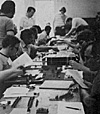 The method I used last year to review Origins '79 was
successful enough for me to attempt the same this year. I
have collected comments and short articles from a whole
list of people involved in, or attending, Origins '80 and have
combined them all in this report along with several
comments of my own.
The method I used last year to review Origins '79 was
successful enough for me to attempt the same this year. I
have collected comments and short articles from a whole
list of people involved in, or attending, Origins '80 and have
combined them all in this report along with several
comments of my own.
At right, 15mm game in progress. Photo by Philip Stearns.
A thank you is due to the following people for their inputs: Bob Beattie, Jay Hadley, Eric Ritchie, Pete Hollinger, Curt Johnson, Rod Burr, Joe Miceli, Jim Arnold, Pete Rice and a special thanks to Ned Zuparko who provided an incisive review of many of the miniature demos and seminars.
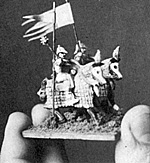 Origins '80 (the sixth in the series) had 4652 (by actual
count) paid attendees over 10 years old. Under 10 years
old attendees were approximately 350. This does not
include dealers, their personnel, various staff members
and helpers. This had to be the largest yet!
Origins '80 (the sixth in the series) had 4652 (by actual
count) paid attendees over 10 years old. Under 10 years
old attendees were approximately 350. This does not
include dealers, their personnel, various staff members
and helpers. This had to be the largest yet!
At right, Best Painted Byzantine Army (Rod Burr). Photo by Philip Stearns.
As you all know, I was Chairman for Miniatures and I want to thank all those who gave of their time to put on all the miniature events. Including seminars, there were 79 HISTORICAL Miniature events - game openings for some 700 Historical Miniature Gamersl After all the complaining about not enough miniature events at conventions I was surprised and not a little disappointed that many of the Historical miniature events were not filled. In fact several were cancelled because of a lack of interest! There were also many SF, Fantasy and Role Playing miniature events.
The overall success of the show was due to the hard work of Tom Fillmore, John Corradin, Bob Frantz, Shawn Carroll, Tom Carroll, Mary Jo Frantz, Jay Hadley, Alfred & Esther Hartmann, Omar DeWitt, Bob Beattie and many others. This year's Origins was the best organized so far and went off fairly smoothly.
The fact that all the miniature events (except seminars and the 3 all-righter games) were in MacMoreland Hall with the dealer area meant that many attendees not normally into Historical Miniatures got a chance to kibitz and see what it was all about.
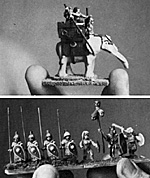 At right, Mike's models 15mm ancient elephant--part of army that won "Best Painted 15mm Army" in the competition. Bottom, Byzantine (at left side of shot) and Early British (right). Byzantines won "Best Painted 25mm Army used in a tournament." Photos by Philip Stearns.
At right, Mike's models 15mm ancient elephant--part of army that won "Best Painted 15mm Army" in the competition. Bottom, Byzantine (at left side of shot) and Early British (right). Byzantines won "Best Painted 25mm Army used in a tournament." Photos by Philip Stearns.
This apparent advantage to Miniature games was a mixed blessing. Demonstration games received a larger audience and interest from a passerby trying to find the dealer's area but tournaments were overcrowded for the same reason and eventually attendance to them had to be limited. It seemed obvious that last minute changes were made to accomodate dealers who signed-up late, the result was an over crowding in the dealer area with which the air conditioning could not cope.
Registration was better handled than last year with the desk manned at all reasonable hours. Widner College threw a few monkey wrenches. They reneged on at least two promises: One, to keep MacMoreland Center (games area - not dealer's area) open 24 hours. This caused the last minute harried relocation of the all-righter games. And two, to allow the use of the front foyer in MacMoreland as a game table space. This probably caused a few people to miss their game when they could not find its new location.
I understand that unbeknownst to The Origins '80 staff, the college had also scheduled other events in several of the areas given to Origins. This caused quite a few last minute shufflings. The last problem was the demeanor of some of the students hired to police admittance to the dealer's area. They came close to getting physical on a couple of occassions. Knowing some of the people that had to put up with these situations, I can understand how they felt but believe that people in the position they were in - dealing with the public - have to be above anger at all times.
THE HOBBY CENTER
The Hobby Center run by Bob Beattie, Bill Marshall and Bob Sarber was very popular and of special interest to the casual visitor who is not into the hobby but just came to see what was going on - there were a few hundred of thesel The Hobby Center had displays of every manufacturer's figures & boardgames, demos of HG Wells and other simple miniatures rules as well as the "Time Line". The "Time Line" is a displayed history of the hobby, both miniature and boardgame, indicating how it grew and delineating various events and highlights. I found it enlightening, even to a gamer of long standing, and was surprised by some of the facts of the hobby's history.
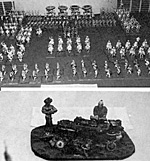 At right, Eric Ritchie's Ancient Chinese army--an award winner. Photo by McLean. Bottom: best painted role-playing figures. Photo by Philip Stearns.
At right, Eric Ritchie's Ancient Chinese army--an award winner. Photo by McLean. Bottom: best painted role-playing figures. Photo by Philip Stearns.
Part of the Hobby Center this year was "The Creature That Ate Chester" a miniatures version of T.C.T.A. Sheboygan. Bob Beattie has put this on at several conventions and tells me that the win (in a close game) by the humans (Sand or loffe) this time was the firstl The monster was operated by Brandon Brylawski.
The highlight of Hobby Center activities is the painting competition. This year it was judged by Charles Sweet, Philip Stearns, Jay Hadley and Joe Miceli, all award win- ners themselves. This year an entry was awarded extra points if he could be shown that the "wargame" unit is indeed use in wargames by its painter. It is about time that it is recognized that we are painting WARGAME figures; NOT collector figures!
PAINTING COMPETITION WINNERS | |
| ANCIENT UNIT | Eric Ritchie |
| MUSKET UNIT | Rob Mosca |
| MODERN UNIT | Cary Gillette |
| FICTIONAL UNIT | Steve Aleo |
| ANCIENT ARMY | Eric Ritchie |
| FICTIONAL ARMY | Mike Barbaro |
| MUSKET ARMY | Robert Coggins |
| PLAYING/SKIRMISH FIGURES Steve Aleo | |
SPECIAL AWARDS | |
| THE COURIER -- BEST HISTORICAL UNIT | Rob Mosca |
| THE COURIER -- BEST: ENTRANT UNDER 16 | James Lipman |
| WARGAMEIt'S DIGEST -- BEST WARCAME ARMY | Robert Coggins |
| RAL PARTHA CUP | Rob Mosca |
| MINIFIGS AWARD | Eric Ritchie |
| THE DRAGON -- BEST CONVERSION | Steve Aleo |
H.G. WELLS AWARDS | |
| BEST HISTORICAL SERIES | GDW SYSTEM SEVEN |
| BEST FANTASY/SF FIGURE SERIES | RAL PARTHA'S COLLECTABLES |
| BEST VEHICULAR MODEL SERIES | MARTIN METALS ORGE |
| BEST MINIATURE RULES 1979 | GDW SYSTEM SEVEN |
| BEST ROLE PLAYING RULES 1979 | COMMANDO, SPI |
| BEST ROLE PLAYING ADVENTURE 1979 | KINUNIR, GDW |
| BEST MAGAZINE COVERING MINIATURES | THE COURIER |
| BEST MAGAZINE COVERING ROLE PLAYING | JOURNAL OF THE TRAVELLERS AID SOCIETY |
| ALL TIME BEST 20TH CENTURY NAVAL RULES | GENERAL QUARTERS, BROOKHURST |
| ALL TIME BEST ANCIENT and MEDIEVAL RULES | CHIVALRY & SORCERY, FGU |
CHARLES ROBERTS AWARD | |
| BEST PRE-20TH CENTURY GAME 1979 | NAPOLEON AT LEIPZIG, OSG |
| BEST 20TH CENTURY GAME 1979 | CITY FIGHT, SPI |
| BEST FANTASY/S.F. GAME 1979 | CREATURE THAT ATE SHEBOYGAN, SPI |
| BEST INITIAL RELEASE 1979 | IRONCLADS, YAQUINTO |
| BEST MAGAZINE COVERING BOARDGAMING | FIRE & MOVEMENT |
| BEST AMATEUR MAGAZINE IN GENERAL | PERFIDIOUS ALBION |
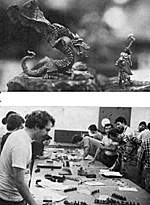 At right, Ral Partha figures, and 25mm ancient tournament. Photos by Philip Stearns.
At right, Ral Partha figures, and 25mm ancient tournament. Photos by Philip Stearns.
One thing that was very noticeable was that most of the 25mm miniatures manufacturers brought few, if any, historical figures with them. An exception to this was RAL PARTHA, who were very disappointed during the convention by the low ratio of historical figure sales to fantasy figures.
The only new historical Miniatures there were JACOBITE, 15mm Napoleonics, sold by The Ship Shop of Annapolis, MD. They were very popular and I understand that he sold out. Besides figure quality their popularity is in part because they carry many of the lesser states: Baden, Poland, Sweden, Wurttemburg, etc.
TOURNAMENTS
 There were fewer miniatures tournaments but many
demonstration games ALL of which encouraged active
participation. The major miniatures tournaments were
the WRG armor tournament and the WRG Ancient tournament.
There were fewer miniatures tournaments but many
demonstration games ALL of which encouraged active
participation. The major miniatures tournaments were
the WRG armor tournament and the WRG Ancient tournament.
At right, top, Gloria Miceli, Jennifer Chaskes, Claire Cronin, Joe Miceli, and Philip Stearns. Photo by MacLean. Bottom, Best painted Ancient Unit by Eric Ritchie. Photo by MacLean.
The WRG armor tournament sponsored by THE COURIER and AWA was slightly under subscribed with twelve 3-man teams out of a possible 16, with a minority of them having preregistered.
The WRG armor tourney umpired by Rod Burr, Mark Chilenskis, Mark Swanson and John Noon, consisted of three rounds between teams. Both WRG WWII and Modern rules were used in the elimination. After a very close final the winning team, from Battle Group Boston, was Jorge Chavier and Al Garnache. The runners up were Robert Kunz, lames Voshell, and Bill Herdle.
The WRG Ancient tournament was divided into 15mm and 25mm tourneys. Each person played 2 games, the best players were then selected by the judges (Tom Haxlett and Steve Herden) for a 3 round elimination. The winning 25mm player was Canada's Richard Wilson - he won a 1000 point army from Hinchcliffe. Runner up was Ross MacFarland also of Canada. The 15mm tourney was won by Larry Duffield (organizer of Origins '81) who won a 1000 point 15mm army from Mike's Models.
The best painted 25mm army ($25 gift certificate from Hinchcliffe) was Rod Burr (The Courier's Modern Editor.) The best painted 15mm army was not abailable to me at press time. Ned Zuparko (miniatures chairman of Origins '81) attended many of the seminars and observed several demonstrations. The following is his verbatim critique:
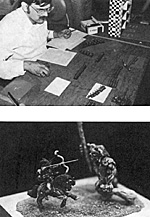 At right, top, Larry Duffield (organizer of Origins '81) winning the final of the WRG 15mm ancient tournament. Photo by MacLean. Bottom, Dragontooth figures painted by Joe Miceli. Photo by Philip Stearns.
At right, top, Larry Duffield (organizer of Origins '81) winning the final of the WRG 15mm ancient tournament. Photo by MacLean. Bottom, Dragontooth figures painted by Joe Miceli. Photo by Philip Stearns.
Tactics of 18th Century by Brent Nosworthy (OSG). This event almost died early as Brent used a blackboard (without eraser) to go through complexities of drill books. By the end of the seminar, though, some very interesting ideas and interpretations emerged. Brent proved to be a good example of a designer using research and interpretation, making this a useful seminar for designers.
Boardgames for Miniatures Campaigns (OSG) VERY disappointing. Little or nothing new or useful. Basically a progress report on a local club's campaign. OSG plans to charge $2.00 for copies of their combat tables used by the club. I've forgotten the name of the presenter (it was not Brent), but he wasn't really well prepared - just sort of a rambling presentation interspersed with many Q & A that didn't advance the art at all.
Napoleonic Tactics and Grand Tactics by Jim Getz. A well-prepared, thoughtful presentation. There was little new about Napoleon's system, but it's practical connection to the tabletop was very well done, and the use of systematic analysis of old maps and historical sources are a good example of historical research to design a game for those new to the hobby or those wanting to design a game in this era.
Development of Empire III by Jim Getz and Scotty Bowden. A real surprise. Advertised as"further improvements" in Empire, it drew a large crowd of Empire players expecting to hear the latest rule change. Instead the ENTIRE game has been changed; keeping only the figure mounting since many people have already mounted figures in that style. In the seminar Scotty admitted Grand Tactical battles in Empire II can take "all day" sometimes even 16 hours to play! This system is supposed to cut that time in half and emphasize Grand Tactics. Scotty showed a great deal of historical integrity by totally overthrowing his own design (Empire II) for a new one that seems to be, if not entirely, then largely designed by Jim Getz. The new system contains a self-described "revolutionary" design that is totally "untraditional" (it is a derivation from the old Jones-Getz articles in THE COURIER). It is very interesting, though open to debate about some parts of it.
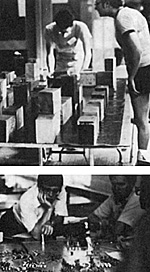 At right, "The Creature that Ate Chester" game by Bob Beattie. Bottom, Tom Hazlet (center>, umpires final WRG 25mm Ancients tournament. Photos by Jani Daum
At right, "The Creature that Ate Chester" game by Bob Beattie. Bottom, Tom Hazlet (center>, umpires final WRG 25mm Ancients tournament. Photos by Jani Daum
The most intriguing question is Bowden's apparent commercial gamble. Will those who have committed themselves to a traditional Empire II go along with an unproved "revolutionary" new set of rules just because Bowden-Getz have? And will other players give up the traditional game format of "turns" and sequence of play to play Empire III? Audience reaction was mixed.
One highlight was Getz's presentation of "history" of miniature wargames in USA, especially has presentation of games as analogies, not "realism", since "realism" is impossible. Iim said one can claim his game is better analogy, but more "realistic".
"Napoleon's System of Maneuver" by Avalon Hill was Highway Robbery! A total contrast to the Getz presentations. First, the subject was changed since one presenter "was in Okinawa". Therefore we got a disjointed Q & A session, combined with some reading from Sun Tzu. The panel was made up of 5 of the top boardgame designers; John Prados, Kevin Zucker, Nelson, Davis and one other. Not well prepared (I think it was an ad hoc grouping, so not their fault).
The disturbing thing about this seminar was the apparent contrast between miniatures people (as in Getz's presentations) and boardgames as embodied in this panel. The miniatures approach seems to be an interest in HISTORY, which translates into looking up facts, then making a game interpretation from that.
The boardgame approach seems to be an interest in GAMES AND GAME MECHANICS, which translates into having pre-conceived notions of, or theories of, history that are applied to all historical eras, more or less independent of facts or differences between those eras.
Thus, my own (miniatures-biased) opinion is that miniatures designers would tend to take facts and build a game system from that; the boardgame designer takes a game system and adapts the facts to the system.
I would quote one item from Kevin Zucker made at the seminar as support for my idea - he (supported by other panelists - the creme of boardgame design) said that Chandler was really "working backwards" in his attempt to interpret Napoleonic history! From my point of view, Zucker is backwards, which explains why, from HIS point of view, Chandler is backwards!
When Mr. Davis was asked a question from the audience questioning one of the concepts, he replied "I can't relate to that question"; the panel snickered, and went on. Some of the "choice" ideas presented there were: Bertheir actually handled the orders to the troops, since Napoleon had to concentrate on his 1813 supply lines etc.; Napoleon, being a "man of action", was INCAPABLE of explaining his system, even if he had wanted to! All generals of that era were "out of their depth" and didn't really know what they were doing; Clausewitz concentrated on the "material" aspect of warfare, and not on the "humanism" or personal aspect of command.
One final contrast- 2 hours earlier Getz had used the battle of Waterloo as an example of good staffs and aide-de-camps getting info to and from the Generals, especifically Wellington, so they could get to threatened sectors. (using a fact to explain).
This panel claimed that, "somehow", Wellington KNEW "ahead of time" just where crises would occur, and by going to those spots fusing this "prescience" was able to guarantee his win. (Using their theory of history of Wellington's ability overcomes all physical facts.)
All of these "facts" the panel mentioned can be seen to have a "grain of truth" from a quick reading of historical sources - but to someone knowledgable in a particular area, the shallowness of the boardgame designers' interpretations is obvious!
And the audience swollowed it!
Rule Writing by Arnold Hendrick was well-organized with some good info for designers, but lack of audience participation hampered an effective presentation, forcing Arnold to focus on a few details on "using point values" for creating armies, in response to one of the few questions.
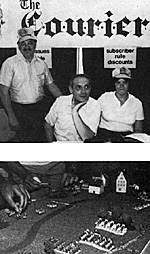 At right, top, Dick Bryant, Leo Cronin, and his daughter hold down Courier fort. Photo by McLean. Bottom, demo gamne of "battalionmasse" rules. Photo by Jani Daum.
At right, top, Dick Bryant, Leo Cronin, and his daughter hold down Courier fort. Photo by McLean. Bottom, demo gamne of "battalionmasse" rules. Photo by Jani Daum.
Sword and the Flame a colonial game demo of the Yaquinto rules put on by Larry Brom, The Triagle Simulation Society and the Mississippi Simulation Society. I played in a Zulu-British game in the Natal. Larry's group stressed GOOD FELLOWSHIP and cooperation in a game for fun! Very enjoyable. Another refreshing aspect was that they would point out historical occurrences when they happened in the rules, buy made no bones about sacrificing "realism" to simplicity or playability if that made the game more fun.
Limited Intelligence in 19th Century Games John Prados' seminar on "Hidden Movement" boardgames was another ill-prepared example of boardgame thinking that showed some game mechanics but discussed nothing new or useful, and also did not really delve into the ideas.
Personal Observation on Napoleonics Trend. I gave, participated in or observed 4 types of Napoleonics games at Origins. Each, while different in details, were very similar in purpose; all seemed interested in getting into the Grand Tactics simulation rather than Tactics. Naturally, I think my own was best, but it seems to signal a shift in thinking about the era.
- a) Batallion Masse demonstrated as the Black Forest 1805 (by Order games) used a 1:90 organization, but was still using battalion level as the basic unit. Also used a hex grid on table for movement.
b) Generalship Napoleonics by Jim Arnold used brigades and divisions as basic units, but the mechanics seemed to be fairly traditional.
c) Empire lil demo indicates that it's new play sequencing/time scale system will allow simultation of both tactical and grand tactical decisions, but will emphasize grand tactics.
d) My Vive L'Empereur deliberately abstracts tactical decisions to concentrate on Grand tactical maneuver decisions, using a unique command initiative and movement system.
APOLOGIES
I apologize to the winners of various events and tourneys which I did not mention. The various organizers of these events have yet to send me their list and we must go to the printer. If I eventually receive the lists, THE COURIER will publish them. I am assured that, unlike previous years, each winner knows that he won and has received his plaque or certificate. In the case of people winning gift certificates or armies etc. Their names amd addresses have all been submitted to the donor in question.
NEXT YEAR
Next year, Origins '81 will be in California. But, I am told, by those who ran Origins '80, that there will definately be an "EASTCON" or a "PENNCON" or some such at Widner College in June or IUIY in 1981. Watch these pages for more details.
Back to Table of Contents -- Courier Vol. 2 #1
To Courier List of Issues
To MagWeb Master Magazine List
© Copyright 1980 by The Courier Publishing Company.
This article appears in MagWeb (Magazine Web) on the Internet World Wide Web.
Other military history articles and gaming articles are available at http://www.magweb.com